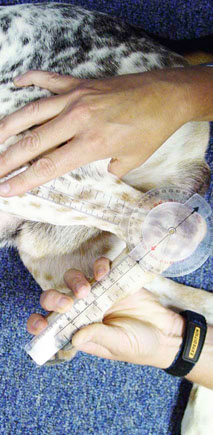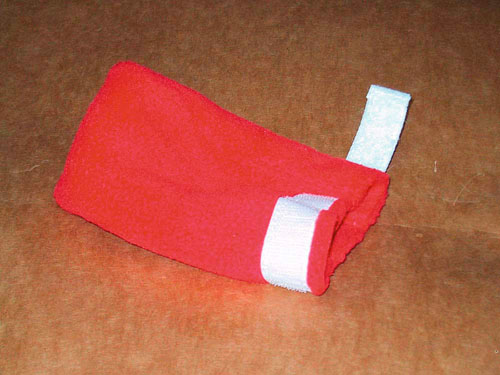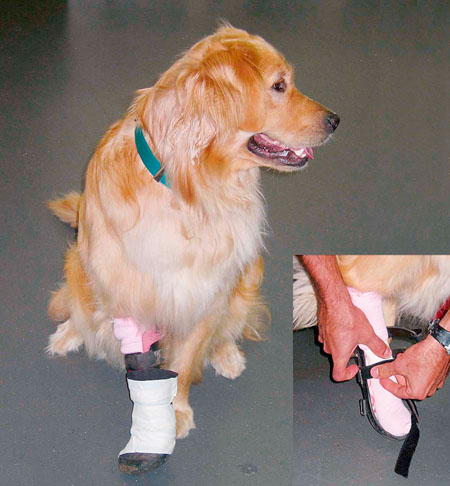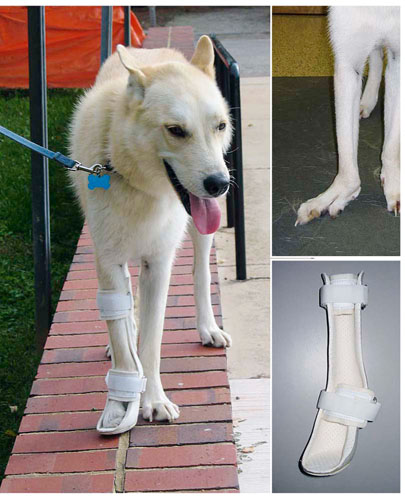Independent locomotion is critically important in dogs and cats. In fact companion animals that have lost the ability to walk independently are at risk of being euthanatized.1 Many devices have been conceived to provide ambulation assistance and independence from owner care.2 Humans use canes, crutches, braces, orthoses, and prostheses to assist with locomotion.3,4 In recent years the veterinary profession has been increasingly involved in physical rehabilitation for weak and paretic patients, and multiple devices aimed at providing ambulation assistance to animals have been created and used.2,5 The devices used to assist companion animals may support or protect weak, unstable joints or feet (orthoses, boots); replace a missing portion of a limb (prostheses); or facilitate locomotion (slings, carts, ramps, steps). Assistive devices may also decrease the complications present in recumbent patients, including decubitus ulcers.2 The purpose of this chapter is to present the range of ambulation assistive devices and discuss their purpose, benefits, construction, and functional use for companion animals. Assistive devices present unique challenges to rehabilitation clinicians because their design, fabrication, fitting, and the patient training are most often unique. Their successful use requires an accurate assessment of the biologic situation and the mechanical needs of the patient, requiring knowledge in the fields of orthopedics, rehabilitation, biomechanics, and prosthetics.6 Boots are used to protect pads and feet from abrasion or to provide support. They may be used in normal dogs to protect against abrasions created by rough surfaces; for example, for search and rescue dogs working in areas with broken glass. Sled dogs may wear fleece boots to avoid the accumulation of ice on their feet or to avoid skin lesions from ice crystals, for example (Figure 17-1). Boots may be used to avoid abrasions of the dorsal surface of digits and metatarsal bones of dogs with sciatic nerve palsy, provided that they have some residual hock function. If the hock is flaccid, a support orthosis may also be necessary to maintain the lower limb in a functional standing position. Similarly boots may be used to protect the dorsal surface of the manus in patients with palsy of the branch of the radial nerve that innervates the extensor muscles of the antebrachium (Figure 17-2). Because most radial nerve palsies or brachial plexus injuries also affect the triceps brachii muscle and therefore severely limit weight bearing by the entire forelimb, boots may not provide adequate support alone. Boots may also be used in dogs with degenerative myelopathy and other conditions that lead to scuffing of the feet. Boots must be lightweight, particularly for patients that have weak motor function because the added weight of the boot on the foot may further decrease limb use. Boots may be made of nylon mesh, cotton, fleece, neoprene, rubber, or other materials. They may have a rubber sole for increased traction.2 They may be held in place through the use of straps or hook-and-loop fasteners. Bootstraps are most often placed immediately proximal to the distal portion of the metacarpal or metatarsal bones in order to secure the boot. Orthoses are devices applied to limbs for support and protection. They are applied on limbs in order to assist or limit joint motion. The most common orthoses are used to restrict the excessive joint motion present in patients with ligamentous or tendinous problems, including patients with ruptures of their palmar fibrocartilage or common calcaneal tendon (Figure 17-3). Orthoses function by placing the limb segments proximal and distal to unstable joints in a foam-lined rigid shell. Orthoses are most often made of rigid thermoplastics. They may be lined with foam, fleece, or terry cloth. They are most often held in place with hook-and-loop fasteners. Orthoses may be commercially available premade or they may be custom made. Premade orthoses are affordable and are best suited to patients with normal anatomy and healthy skin (i.e., patients with rupture of the common calcaneal tendon). Custom orthoses are usually necessary in patients with abnormal anatomy (limb deformity, abnormal skin contours) and in very small or very large patients. They are generally based on a cast of the abnormal limb made by use of semirigid or rigid fiberglass or plaster of Paris. They may also be based on a computed tomography–based replica of the limb. Solid replicas may be made of cyanoacrylate-impregnated plaster, ABS plastic, or laser-cured photopolymers.7 Orthoses may be hinged to enhance their functionality.8 The hinges most often connect rigid shells placed around the pes (or manus) and the crus (or antebrachium). These hinges may be passive or dynamic (i.e., spring loaded). Passive hinges may be made of nylon or metal (Figure 17-4).8 Orthoses with passive hinges may enhance limb function because part or all of the motion of the tarsus (or carpus) may be maintained. Orthoses may have dynamic hinges that may be used to enhance the support of weak joints or to stretch contracted joints. Hinges are made dynamic by using springs embedded in the hinges or elastic bands.
Devices for Ambulation Assistance in Companion Animals

General Considerations When Using Assistive Devices for Ambulation
Boots

Figure 17-1 Fleece boot made for a sled dog. The boot has a simple design, with a single hook-and-loop band used to secure it in place. These boots are placed on all feet during sled dog races. They protect the pads from abrasions and other injuries caused by snow and ice.

Figure 17-2 Golden retriever with a partial brachial plexus avulsion sustained as a result of a fall from a moving vehicle. A palsy of the radial nerve is present. Function of the triceps brachii is weak and antebrachial extensor function is absent. The dog is seen wearing a sock, a folded bandana taped on the caudal aspect of the carpus, and a support orthosis (inset) placed inside a boot, stabilized with athletic tape. Although gait abnormalities remain (the affected forelimb is placed under the chest by abducting and externally rotating his humerus at a walk), the dog is nevertheless able to bear weight on his affected limb.
Orthoses, Including Sleeves and Braces

Figure 17-3 Siberian husky with ectrodactyly (lobster claw deformity) of his right forelimb. The right carpus collapses when bearing weight (upper inset). A custom orthosis has been made that supports his carpus (lower inset). The stability of the limb within the orthosis could be optimized by placing a third strap across the distal aspect of the radius.![]()
Stay updated, free articles. Join our Telegram channel

Full access? Get Clinical Tree


